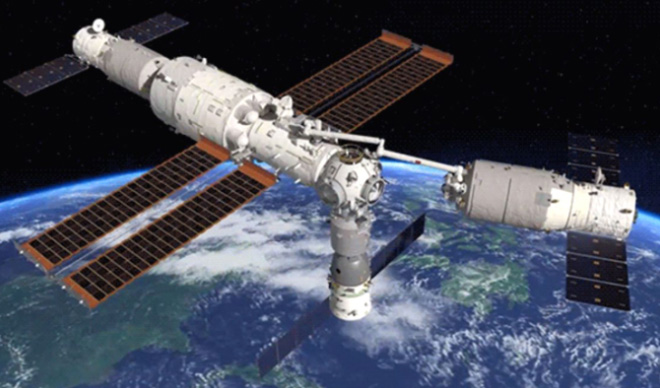China develops technology to control space robots with brains
In the future, Chinese astronauts can control the robotic arm of the Tiangong space station with brain waves with 99% accuracy.
A team of China's manned space program has developed technology that allows astronauts to control robotic devices using brain waves, SCMP reported on March 25. New technology could change the way the giant arm on the Chinese space station is operated - a sophisticated instrument with many flexible components.

Illustration of the robotic arm on the Thien Cung space station during the Tianzhou 2 cargo ship displacement test on January 5, 2022.
Until now, the robotic arm was still controlled by astronauts with joysticks and keyboards. This is sometimes very difficult to do in a weightless environment. Meanwhile, current brain-controlled technologies usually only control the robotic arm with an accuracy of 40% - 80%, lower than the standard required in space.
However, a simulation of the new brain-computer interface gave it more than 99% accuracy. Meanwhile, the average accuracy when using the keyboard is only about 92%.
The new device will be head-mounted and is said to be easy to use. "An untrained person can also use it to give commands with relatively high accuracy and speed," said Professor Wang Congqing and colleagues. Their study was published in the journal Computer Measurement and Control in February.
China is the first country to send brain-controlled technology to space. During the 2016 Shenzhou 11 mission, astronauts Jing Haipeng and Chen Dong used a mind-reading device designed to aid their work.
The new test took place at the China Astronaut Research and Training Center, Beijing. Details of the trial have not been released. However, according to Professor Huang Weifen, the system's deputy designer, the experimental data shows that the new technology has great potential.
Thien Cung space station will use brain-controlled technology after the main structure is completed, expected by the end of this year. The workings of the human brain are incredibly complex, and a major challenge with this technology is separating useful signals from background noise.
The wearer of Wang's device needs to look at a simulated robotic arm on a computer screen. Each part of the arm blinks at its own rate, and focusing the eye on a specific part stimulates brain waves of the same frequency to form. This helps the machine read minds, but useful signals are rare and mostly weak. To increase the device's performance, Wang's team used artificial intelligence to detect associations between seemingly unrelated brainwave patterns, thereby obtaining additional information.
In the test, 35 volunteers moved or rotated a virtual robotic arm with their thoughts, of which 11 completed the task without a hitch. According to the team, the average accuracy was 99.07%. This rate was slightly lower with 27 volunteers with no experience, but still reached 98.9%.
The machine can recognize commands almost immediately. The team of experts estimates that the "bandwidth" of information transmitted from the brain to the computer reaches 150 bytes per minute, nearly 10 times higher than the old method. It is not clear when the new technology will be used in space missions. However, Wang's team says it will soon be upgraded to handle more complex tasks, providing greater accuracy and speed.
- Russia develops technology to control robots in space
- First control the robot on Earth from space
- Robot doctor in space
- The US military is about to apply brainwave technology to control robots
- Chinese scientist develops 'electronic skin' that connects humans and robots
- Waiter in China
- Robots help American businesses fight China
- Research the bee brain to develop self-flying robots
- China develops snake robot capable of crushing satellites in space
- Philosophy for robots
- China launches automatic parking with robots
- Control the robot by thinking
 Van Allen's belt and evidence that the Apollo 11 mission to the Moon was myth
Van Allen's belt and evidence that the Apollo 11 mission to the Moon was myth The levels of civilization in the universe (Kardashev scale)
The levels of civilization in the universe (Kardashev scale) Today Mars, the sun and the Earth are aligned
Today Mars, the sun and the Earth are aligned The Amazon owner announced a secret plan to build a space base for thousands of people
The Amazon owner announced a secret plan to build a space base for thousands of people